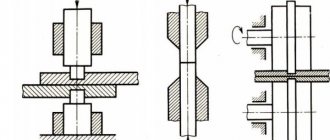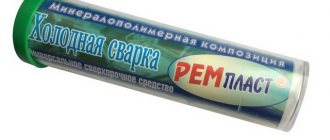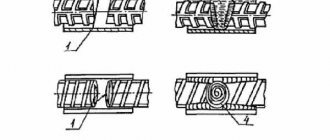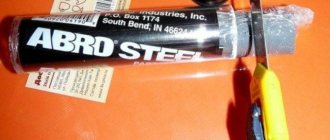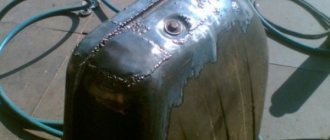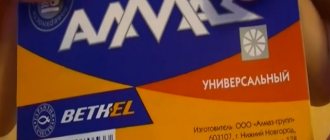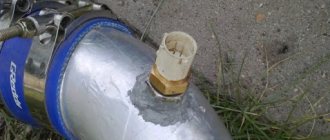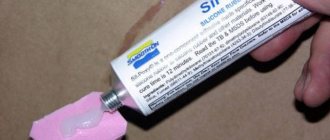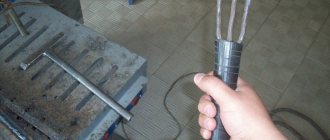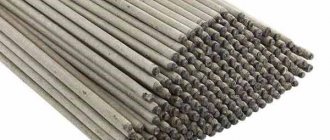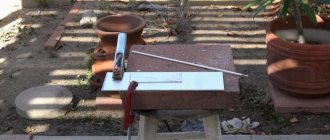Composition and properties
Cold welding is essentially an adhesive for metals. Includes:
- adhesive - epoxy resins, which ensure the plasticity of the composition and its uniformity;
- filler – metal powder;
- activating additives (sulfur).
The strength of the weld seam depends on the suitability of the adhesive composition for the types of metals being welded, on the quality of preparation of the bonded surfaces and its proper use. Under optimal conditions, the strength of the seam reaches the strength of the metal, but in practice, no matter how hard you try, it is almost impossible to achieve ideal conditions, and accordingly, the strength of the seam will be significantly lower than with hot welding. For this reason, it can only be used for minor repairs and welding of parts that do not carry a large load.
The temperature limit of the resistance of the seam depends on the composition of the glue. This indicator can be found on the packaging and if the gluing technology is followed, the seam will be strong within the specified temperature value.
For inexpensive formulations, the maximum temperature is set at 260 degrees. Special adhesive compositions allow the weld to not lose its strength at temperatures of about 1300 degrees. These compositions are used where products operate at high temperatures and in situations where it is impossible to use traditional welding.
Types of cold welding
The trading network offers cold welding made in Russia at low prices and expensive imported ones. Depending on the position of the seam and the parts being welded, the following types of cold welding are distinguished:
- for fastening busbars or linings to wires made of copper and aluminum, handles to aluminum utensils - point;
- for the manufacture of dust- and moisture-proof cases and devices for various purposes and thin-walled containers - suture, which is produced using contour punches;
- when connecting wires and making rings - butt;
- fastening brass pins to the terminals of transformer windings made of aluminum, manufacturing corner and T-shaped busbars for electric locomotives - T-shaped;
- connection of water and heating pipes, transition elements in railway power lines - shear welding.
According to consistency and readiness for use, cold welding is made:
- fluid two-component. In this case, the resin is mixed with a hardener before application to the surfaces to be bonded;
- in the form of a plasticine-like mass - a bar or an elongated cylinder, consisting of one or two layers of reagents. Before work, having pinched off the required amount of mass, it must be kneaded with your fingers, like plasticine.
According to the direction of use, the following types are offered:
- metal welding – glues various metals together, containing a metal filler;
- car repair - the composition is designed specifically for the repair of car parts; it contains a metal powder filler;
- universal – cold welding for plastic, metal and wood. Of all types of welding, it is the least durable;
- special – for work in special conditions (underwater, in an explosive atmosphere).
Description of the liquid welding method
Liquid welding for metal, or also called cold welding, is a polymer adhesive consisting of one or two components. Regardless of the number of components, it has high adhesiveness to metals, the heat resistance of which reaches 1316 degrees. It is able to quickly harden in air and does not react with petroleum products contained in gasoline, motor oil or diesel fuel. Thus, this type of connection is not welding in the traditional sense.
The seam cannot withstand the same load as the base metal and this method is most often used for minor repair work.
The adhesive contains:
- epoxy resins as a base, on which the uniformity and ductility of the seam depends;
- metal filler;
- additional substances for joint strength.
High temperature cold welding is available on the market in two versions:
- A liquid composition based on epoxy resin, hardening when interacting with a hardener. This glue has almost no smell and emits harmful substances. The composition is convenient to combine with metal and woven reinforcing elements.
- Plastic glue is a special putty similar to plasticine for children's creativity. It is available in the form of two bars or one bar consisting of two layers.
The quality of work depends not only on the adhesive composition, but also on strict adherence to technology. The connection is stronger than the parts being glued, although traditional welding still produces a stronger connection.
Cold Welding Selection
Among the huge number of different products on the market, there are many low-quality goods. To choose a good welding adhesive wisely, you need to pay attention to the following aspects:
- It is necessary to take into account the properties of the metal surfaces being bonded.
- The temperature range of the product should be as wide as possible.
- You must carefully study the instructions supplied with the product and take into account the recommendations for its use when working.
In special stores you can purchase domestic or foreign glue for joining various metals. Of course, products from Russian manufacturers are much cheaper than imported analogues, but there are complaints about the quality of the connection. Among domestic adhesive compositions for metal, experts advise choosing Polymet and Almaz.
If the metal adhesive is produced by well-known companies ABRO, Hi-Gear, Loctite, Devcon, Poxipol, WEICON or Permatex, you can be sure of its quality. It is also necessary to pay attention to the price tag, which for real branded products will, of course, be higher than for an underground homemade tube of dubious quality.
Where is liquid welding used?
The technology of joining metals without a welding machine is quite new and is most often used in the following cases:
- when repairing automobile bodies and spare parts in a special workshop, in a garage or on the road;
- for repairing damaged pipes, pumps, fittings and other plumbing equipment;
- in the repair of gas equipment;
- for reliable sealing of metal-plastic window frames.
Auto repair shops usually use putties, but if you need to get a stronger and more reliable connection, liquid adhesives are used. Before use to seal a damaged tank or radiator, there is no need to drain the fuel, since the adhesive composition does not react with petroleum products and hardens quickly. Auto mechanics greatly appreciate this property of cold welding and note the cost-effectiveness of glue in any form.
The resistance of cold welding to high temperatures is used to repair bodies, pallets, exhaust pipes, fuel tanks, car crosspieces and mufflers, furnaces and boilers, agricultural equipment, exhaust manifolds, household electrical appliances, ship engines and in other cases where conventional welding cannot be used. Cold welding is used not only for gluing metal, but also for restoring ceramic products and other household repair work.
Features of the use of cold welding
Various works using welding adhesive are carried out according to the same scheme. If you believe the instructions included with cold welding, no special skills are required to work with this substance. You need to follow the recommendations that apply in any case:
- To prepare the surface, you need to clean the metal parts using an abrasive material. After cleaning, roughness and scratches will ensure excellent adhesion of the metal and the adhesive composition, and the seam will be strong and last longer.
- The metal is degreased with a special substance or wiped with gasoline in which a rag is soaked.
- To prepare the welded joint, the required amount of liquid substance is squeezed out of the tube or a piece is cut off from a block of putty. The material is kneaded or stirred to a homogeneous consistency, slightly heating up.
- The resulting adhesive composition must be applied to the surfaces and leveled thoroughly and very quickly. Some cold welding grades set in minutes.
- Complete drying occurs within an hour, or can take a whole day, depending on the composition of the glue. If repairs had to be done on the road, it is not possible to wait that long. But in 20-30 minutes the initial hardening of the glue will occur, and then the driver will have the opportunity to at least get to the nearest car service center.
To work with cold welding, you should take into account the recommendations of specialists developed during practical application. Following these tips will make it much easier and safer to use the adhesive:
- To protect your hands, it is recommended to wear special construction gloves, since the adhesive composition contains components that are harmful to the skin.
- It is better to prepare the amount of adhesive composition for work in small portions. This recommendation is justified by the fact that the surfaces to be joined set quickly (primary gluing occurs in 5-20 minutes). If you prepare a large amount of adhesive mixture at once, you may not have time to use it completely and end up throwing it away.
- Liquid adhesive compositions, which manufacturers pack in two syringes (glue and hardener), are mixed when squeezed out. Experienced professionals do not recommend using such a composition, but additionally mix the components in a separate container and only then use it in work.
- Cold welding for metal is also often used for fastening and repairing wooden and plastic products. The instructions provide for the possibility of such use; it must be carefully studied before use.
- The high adhesion rates of modern adhesive compositions make it possible not to clean or degrease the surfaces to be bonded. Even a greasy surface will stick quite firmly. However, cleaned surfaces will bond much stronger.
- Until the moment of complete hardening, the impact of mechanical loads on the glued parts is strictly prohibited.
- The quality of work and good results depend on the accurate measurement of the amount of hardener and adhesive, which must be thoroughly mixed together.
The instructions prohibit the use of the adhesive composition for other purposes, since in this case the manufacturer does not guarantee the strength of the weld.
| Attention Bearing Buyers Dear customers, send your questions and requests for the purchase of bearings and components by email or call now: Delivery of bearings throughout the Russian Federation and abroad. Bearing catalog on the website |
Attention Bearing Buyers
Dear customers, send your questions and requests for the purchase of bearings and components by mail or call now: tel: +7 (495) 646 00 12 [email protected] Delivery of bearings in the Russian Federation and abroad. Bearing catalog on the website
themechanic.ru
Step-by-step instructions on how to properly use cold welding
Is it possible to weld aluminum with a semi-automatic machine?
Before starting cold welding, clean the surfaces to be repaired, removing grease, peeling paint, rust, and other contaminants. Cut off the required amount of epoxy and mix to achieve a uniform color.
For best mixing, allow the epoxy putty to warm to room temperature. After this, apply the paste to the required place.
To make mixing easier and give the material a better appearance, wet your fingers with water. When you apply the finished mixture to the surface to be repaired, smooth it out with your fingers.
until completely hardened.
Remove excess mass before it hardens, preferably using a tool moistened with water.
Adhesives do not contain any solvents or volatile organic compounds, are not flammable, and do not emit toxic fumes.
When repairing a damp or leaking surface, ensure that the patch being installed is at least one centimeter larger than the area being repaired.
To ensure good adhesion, apply epoxy putty along the outline of the patch. You can complete repair work in just a few minutes.
Cold Welding Selection
When choosing, many people have a question whether cold welding produces current. If you are selecting a substance for working with stainless steel, then you should choose brands that contain the appropriate filler. Due to the presence of filler, the substance conducts electric current. In other cases, when cold welding does not contain a filler, it does not conduct current.
It is worth paying attention to the temperature limit within which the composition can operate. Metal parts that require repair often operate at elevated temperatures and this parameter can be quite important. For many cases, drying speed is important, since in the case of an emergency repair there may not be time to wait several hours. For frequent repairs, it is best to take large-capacity packaging, as they are more economical.
Features of the material
How can you seal a gas tankImportant for a motorist to know
Metal glue is most effective where conventional welding cannot be used. The welding mixture has the necessary plasticity to penetrate the metal and thereby combine surfaces.
This welding method refers to deep plastic deformation technologies, when the oxide layer on the surface is destroyed, and the interval between the welded elements is measured by the parameters of the crystal lattice. Due to the increase in the energy level of the materials, a strong chemical bond is formed.
When filling the holes, some of the cold weld should get inside. For large holes, patches are used, which are applied on top and fixed with adhesive material. The finished connection can be subjected to cleaning for subsequent finishing and painting, as well as mechanical processing, including drilling holes and tapping.
Cold welding works great on structures made of ferrous and non-ferrous materials, allows you to join them together and quickly eliminate leaks. It is also an ideal solution for heat-sensitive products.
Joints obtained by cold welding have a significant service life, but subject to the absence of work loads.
The adhesive can be used at low temperatures
Application of cold welding for metal
Metal mimicry chameleon painting
Cold welding for metal, instructions for use of which are in each package, is used in almost the same way as other types of such a product. In order to understand how to use this glue correctly, it will be enough to look at the example of eliminating leaks in pipelines and containers made of metal. What’s convenient is that this welding can be used both in empty and filled containers, and even those that are under slight pressure. That is, for example, if you need to fix a leak in a car radiator, then it is not at all necessary to drain the liquid from it.
Part after repair by cold welding
So, the algorithm for working with such glue is as follows.
First of all, you need to prepare the surface on which the glue will be applied. To do this, it is better to use sandpaper, which is used to clean the surface from dirt and rust. Such cleaning should be completed if metal with scratches applied to it with sandpaper becomes visible on the surface being treated. Moreover, the deeper and more frequent such scratches are, the more reliable the connection will be. Then the surface should be thoroughly dried. You can use a regular hairdryer for this; you don’t need any special technical equipment. Of course, cold welding for metal can also cope with wet surfaces, but one cannot count on high reliability and tightness of such a connection. The next step, which will make the resulting connection more reliable, is degreasing the surface. To do this, it is better to use acetone, which will remove even minor grease stains on the surface being treated. Next, we proceed to preparing the adhesive composition itself. Since this product is not liquid, but rather dense, we use a knife to cut a piece of the required size from the cold welding cylinder
It is very important to make the cut strictly across the cylinder in order to maintain the original proportions of hardener and epoxy resin in the resulting piece. The cut piece must be thoroughly kneaded until a soft and uniform-colored mass is obtained, and so that the product does not stick to your hands, you can periodically moisten them with water.
The process of applying welding to a repaired surface
After you have obtained a soft and homogeneous mass of the product, it must be quickly applied to the surface to be repaired. The technical characteristics of many types of cold welding are such that it begins to harden within a few minutes after preparation, so you need to act quickly but carefully. If you seal the resulting hole using cold welding, it is very desirable that some of the soft mass gets inside it. If such a hole is too large, then it is better to seal it with a metal patch, which is fixed to the surface using cold welding.
In any case, before starting to use cold welding, it is better to read the instructions again or even watch a training video, which can be easily found on the Internet
It is very important to be careful when using degreasers, most of which are dangerous to human eyes and mucous membranes. In general, using such a tool is not difficult, and the connections it allows to obtain are quite reliable and tight.
What are the pros and cons of cold welding
The composition is based on epoxy resin and can be stored for a long time. After applying welding, it will take 20 minutes for the joints to harden. There is a so-called oxide film on the surface of the metal, and glue can destroy it. With the use of new products, parts can be tightly joined together.
In many cases, electric welding is not always suitable for sealing cracks, so cold welding comes to the rescue. It can also be used when it is necessary to glue linoleum, plastic, copper together, as well as for fastening aluminum joints. For surfaces that react to heat, the method used will be most suitable. In environments where there is a risk of fire or explosion, welding is recommended.
The main advantages of cold welding:
- Its application does not require special skills, knowledge or equipment.
- Affordable.
- When applied to the surface, the metal retains its properties and is not subject to deformation.
- Weld strength.
- There is no waste left after using it. In addition, it is safe and, after drying, will have an aesthetic appearance.
Cold welding is used to join various metal materials. If you follow the necessary instructions, the sealed joints and chips will be reliably protected from leaks.
Buyers willingly purchase welding that easily fits onto the prepared surface. You can always seal the holes with a unique, soft material. It mixes well and freely fastens metal and wooden structures. In addition, it easily glues heavy and light materials. For many years, cold welding has remained the best means for fixing seams and holes.
There are excellent products on sale that will help you reliably seal small, large holes in heating systems. When heating up, small cracks often appear in radiators, from which water drips. Therefore, it is impossible to do without such welding. It will firmly seal all the chips, and in the meantime you can find the necessary welding machine. After some time, you can weld the surface.
But there are disadvantages:
- Products welded chemically do not have a long service life, unlike those that have undergone repair work.
- Large defects cannot be completely repaired using such welding; it will only help to eliminate some cracks for a short time.
- If the surface is poorly cleaned before welding, the quality of the fastening will be quite weak.
Using welding to repair polypropylene pipes
Joints in polypropylene pipes should not leak, so in the future it is recommended to use a high-quality welding machine to process polypropylene pipes. It will allow work to be carried out in accordance with technology. The temperature maintained by cold welding depends on the composition and characteristics indicated on the packaging.
If all instructions are strictly followed, the seam will retain its strength. It should be realized that the greatest strength can only be achieved with a more precise application of cold welding. Therefore, compositions with the highest temperatures are used when repairing parts operated under normal temperature conditions.
The adhesive composition used in cold welding is used to connect all surfaces that are heated to very high temperatures, when the possibility of using classical welding is problematic. The mixture can be kept in working order for up to 3 minutes. Therefore, glue should be applied on time.
When gluing two surfaces, they must be firmly fixed using a clamp. The required time indicated in the instructions must pass, after which the composition becomes solid. After repair, the surface can be puttied and painted over. The drying time of the composition can range from 1 to 8 hours. The instructions must indicate the method of using cold welding and its brand. All manufacturer's advice should not be violated, since otherwise the strength of the seams will be the least.
In most cases, cold welding is used to repair cars and heating appliances. In each case, the use of this method has its own nuances, since, for example, repairing a car gas tank allows you to extend the shelf life, which eliminates the need to spend large amounts of money on new parts.
Before work, good access to warped areas of the surface is necessary. There is a usual way to alleviate this problem for yourself if you have a small hole: use a screwdriver to bring it to a rounded shape, and then use a screw to screw it in, which is suitable across the diameter, so that you can strengthen it with cold welding.
The cold welding method used for radiators is one of the popular methods of using these compounds by motorists. You can find exactly where the radiator is damaged by immersing it under water and blowing it out using a compressor. The places where many bubbles appear that come to the surface from the water are places of damage.
The cold welding method will only be a one-time option - the radiator usually cannot withstand long-term use. You can use it to weld a muffler. It depends on the temperature level that the composition can withstand.
It is imperative to use a modification for high temperatures before gluing the surface. This is due to preliminary cleaning and preparation of the part. For example, the service life of a repaired muffler will be longer.
Heating devices require very high-quality cold welding, since the cost of repair if the seam is deformed again after its use is high. Therefore, it is acceptable to use compositions that can withstand a fairly high temperature level, but it is better to use compositions created for constant contact with water.
If the damage is not very large, this method will solve all the problems, and for holes of the largest parameters, cold welding will only be a temporary solution to the repair problem. For routine repairs of metal products, a welding machine is better suited. To repair main components, it is better not to use the cold method, since safety in their work is of paramount importance.
Features of the use of cold welding for pipes and cast iron batteries
Repair of pipes or cast iron batteries is often required. For these purposes, it is advisable to use cold welding, since:
- Easy to use. The work can be carried out by a person who previously did not know about the existence of such a repair method.
- There is no damage or deformation of the source materials, since there is no exposure to high temperatures.
- Reliability and quality do not depend on pressure speed, so work takes little time.
- Does not require additional tools or equipment.
- Minimizing energy consumption.
- Fire safety is ensured.
- It is permissible to repair pipes adjacent to containers containing explosive substances.
When repairing cast iron coatings, you need to buy a composition that matches the plane being glued. Then the seam will maintain its integrity under different operating conditions.
What can be sealed with cold welding
The answer to this question is almost everything! The only exceptions are flexible materials. After final hardening, cold welding becomes hard.
- Metals. You can glue together or connect dissimilar materials;
- Plastic. Anything except polyethylene. Again, remember the rigidity of the joint;
- Ceramics, stone, glass. In any combination without restrictions. A tile glued end-to-end breaks in any other place, just not along the seam;
- Carpeting and linoleum. It can be to the floor, it can be end-to-end.
A separate topic is plumbing. The fact is that the glue material can be wet during operation. This allows you to glue damage to heating radiators or water pipes without draining water from the system.
You can imagine how “happy” the residents of an entire building will be in the middle of winter if all the apartments are left without heat for the whole day while your heating is being repaired. And with the help of cold welding you can quickly fix the leak yourself.
The repairs will last until the end of the heating season. Although, following the saying: “there is nothing more permanent than temporary,” our people simply “forget” about the temporary seam, and cold welding lasts well for years.
By the way, the lack of hygroscopicity is used not only when repairing current plumbing. When you mix the glue components (and it is more convenient to do this with your hands), the sticky mass sticks to your fingers. If you wet your hands a little before work, it will be easier to form the composition, and this will not affect the quality of the seam.
Important! This property should not be abused. If it is possible to work “dry”, do not use water
The seam will be more durable.
The next application that makes this glue unique is gluing car mufflers. Of course, we are not talking about a complete renovation. It will not be possible to obtain a power seam. But it’s easy to cover up a hole the size of a finger.
Moreover, we are not talking about a way to “hobble to the service station”; with such repairs you can drive for a long time. The glue will not catch fire or crumble. The only condition is that when purchasing, read on the label what temperature cold welding can withstand.
After this application, there is no need to worry about repairing the radiator at all. These are just “seeds”.
Metals suitable for welding
The list of metals and alloys for which the created product is suitable is varied. The process is characterized by the percentage of the resulting compound to the original thickness. The results of the experimental weldings can be presented in the table:
| Metal | Extra pure aluminum | Technical aluminum | Dur-aluminium | Cadmium | Lead | Copper | Nickel | Zinc | Silver |
| Weldability % | 40 | 30 | 20 | 16 | 16 | 14 | 11 | 8 | 6 |
Conditions for obtaining a reliable connection
- Both surfaces of the materials and fabrics being joined must be subject to deformation;
- The symmetry of the location of the welding mixture in relation to the gluing center. The center of the connection zone is located in the planes prepared for connection. When heated, the metal spreads and destroys the films on the surface. All active centers are connected in seconds, without any length of time or period of dislocation. The films completely disappear from the welding zone without additional help or equipment.
- Increased compression in the area of the center of contact. Strengthening actions at the end of the welding process, i.e. pressure will give better results.
- Cleaning surfaces and edges of connecting parts. They can be washed with special solutions, alcohol compounds, or gasoline.
- It is unacceptable to use abrasive tools that roughen the surfaces, which will make gluing difficult.
- Compliance with the standards of metal quality characteristics: roughness 10 µm Rz, non-flatness 0.1 mm.
Manufacturers
On the domestic market, the most popular manufacturers are foreign companies, since Russian products are of lower quality, as evidenced by numerous consumer reviews. Domestic products are represented by the Almaz or Polymet and Henkel trademarks. The leaders among foreign teams are considered to be Hi-Gear, Abro, Poxipol.
Abro Steel is an American two-component welding for universal use. The material can withstand exposure to various aggressive substances and perfectly retains its properties up to a temperature of +260 C.
Hi-Gear “Fast Steel” is produced for working with metal, plastic and stone. The product provides a strong connection and is resistant to mechanical and chemical influences.
Henkel Moment Super Epoxy is widely used for joining metal alloys and other materials. The composition retains its properties up to a temperature of +140 C.
Uruguayan Adefal Trading SA Poxipol - universal two-component cold welding. The maximum temperature for such products is +120 C.
German Wurth Liuguid Metal Fe 1 is produced for working with ceramic and metal parts and structures. The material does not burn and does not contain solvents. The welding composition ensures its resistance to aggressive substances. The maximum temperature for such products is +120 C.
Cold welding for batteries and water pipes Mastix copes better than all other compounds with the task of sealing cracks and other defects in such structures. The temperature in the pipelines does not exceed the permissible component of +120 C, so the products can be used at home. This welding allows you to create lost parts and new parts.
Kerry “Thermo” metal silicate products have increased viscosity. It has proven itself in working with heat-resistant alloys of steel, cast iron and titanium. The composition is resistant to mechanical stress, therefore it is recommended for repairing automotive parts. The product can withstand temperature changes from +900 to -60 C.
Types of cold welding for metals
There are several different adhesive mixtures and compositions, which are divided into several groups depending on the material that requires connection, the type of work and the procedure.
Spot welding
- allows you to work on connecting copper and aluminum busbars.
- Aluminum wires can be terminated with copper overlays, which will ensure contact between the electrical wires.
- Helps connect aluminum pan handles to the body;
- Replace cast compressed coolers with finned ones that work in power semiconductor devices.
Seam welding
Performed with contour punches.
- Sealing the housing of semiconductor electrical devices;
- Capacitor repair;
- Restoration of metal containers for products and other bulk substances;
- Manufacturing of large volume containers with thin walls.
Butt welding
- Bonding the ends of wiring during installation work;
- Bonding the ends of aluminum wires with copper parts;
- Assistance in waste-free compilation of coils for combining the ends of metal coils;
- Bonding trolley wires when repairing the movement of an electrified vehicle;
- Manufacturing of metal rings;
- Minimizing waste from parts production.
T-welding
- Welding copper-aluminum knives;
- Repair of switchgear and devices;
- Bonding brass studs with aluminum windings of transformer units;
- Manufacturing of T-bar and corner fastenings for electric locomotive bus wires.
Shear welding
Bonding of tubular adapters and connection of pipes entering power lines on railway communication systems. All compositions have different consistencies: liquid and plastic.
- The liquid mixture is created based on epoxy resin. When a chemical reaction is carried out, the composition becomes hard and strong. The distinctive characteristics of epoxy resin make it possible to make the connection not just strong, but also of high quality. You can use “Cold Welding” liquid glue to join metal substrates, reinforcement, building elements and parts: fiberglass, mesh. The glue does not emit liquid during operation, there is no unpleasant pungent odor or substances harmful to humans.
- Plastic composition - special putty mixtures. They look like wooden blocks in one or two layers. You can compare the connecting mixture to dense frozen plasticine.
Rules for choosing a good adhesive mixture for metal products
“Cold welding” can become an indispensable assistant when traveling by car. A minor breakdown on a long journey is annoying, requiring you to recalculate the time and get to a stop at the nearest service station. In addition, when traveling you need every penny; most often everything is calculated down to the smallest detail. It is difficult to spend money on expensive repairs. Therefore, connecting loose parts using a mixture is easy and practical. There is no need to call a tow truck and turn towards the nearest service station.
In the garage of many car enthusiasts who consider themselves real owners, there is such a tool. But for quick and high-quality use of the product, it must be good. Low-quality products can only damage the item they are used for. But among the trade offers there are a lot of fakes. There are certain rules that will help you stop and get the right composition.
Type of surface selected for work;
- The temperature range required to heat the parts. The wider the range offered, the better the welding;
- Availability of detailed instructions;
- Explanation of the rules of use and specific recommendations for use.
When choosing a product, you need to pay attention to the manufacturer. Recommended brands Loctite, Poxipol, Permatex, Devcon, WEICON
They are known for quality and reliability. It is clear that when comparing price offers, these manufacturers set a higher bar, but they promise and deliver the desired result.
Working with cold welding
Adhesive for joining metal parts is very popular primarily due to the fact that to work with it you do not need to have any welding skills and there is no need to purchase special equipment. Anyone can do this job. You just need to study the instructions in detail.
Instructions for using cold welding.
So, to work with metal glue you will need:
- welding glue;
- clamps (if necessary);
- degreaser (acetone);
- sandpaper.
Description of cold welding:
- First you need to prepare the surfaces of the parts to be glued. They must be cleaned with sandpaper and degreased. Surfaces must be dry and rough for better adhesion to the glue. The final result of the work depends on how well the preparation is done. Therefore, take this stage seriously.
- Many compounds easily stick to your hands, which can ultimately disrupt the proportions of the adhesive components. To prevent this from happening, wet your hands with water.
- Two-component adhesive must be mixed with a hardener. If it is a solid plasticine-like glue, then it should be thoroughly kneaded with your hands, the liquid glue is mixed with the hardener in the proportion specified in the instructions. When mixed, the composition tends to heat up.
- After mixing, you need to work with the glue quickly - no more than 3 minutes.
- When connecting two flat surfaces, secure them with special clamps to ensure a secure fit.
- Dry welding can take anywhere from 1 to 8 hours to dry, depending on the type and manufacturer. After this, the repaired part can be puttyed and painted.
- Do not violate the instructions for using glue, otherwise the strength of the weld will decrease.
